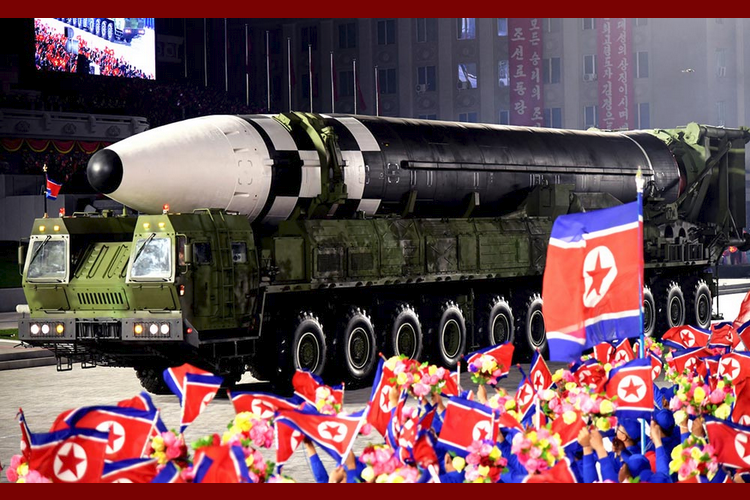 North Korea's Hwasong-16 missile. Image credit: Winluxhuman / Wikimedia Commons
North Korea's Hwasong-16 missile. Image credit: Winluxhuman / Wikimedia Commons
The 2021 Nuclear Triad: Russia, Iran, and North Korea
When people discuss the nuclear triad, they are usually referring to the 3 legs of the American nuclear arsenal: bombers, land-based intercontinental ballistic missiles, and submarine launched missiles. In 2021, the Biden administration faces a triad of nuclear issues it must confront. These three issues—constraining the Russian arsenal, preventing a nuclear Iran, and deterring the North Korean nuclear threat—all require immediate attention that will define the course of nuclear security in the Biden era.
Constraining the Russian Arsenal
For Russia, the solution to the major nuclear threat it poses comes in the form of a New START replacement or renewal. As the treaty, which puts strong limits on the strategic nuclear arsenals of both the United States and Russia, is due to expire in February 2021, the Biden administration is faced with the question of what to do when it expires. Though clearly viewing New START as a “bad deal,” the Trump administration was late to the game in its efforts to negotiate a replacement for the treaty. By attempting to coax China into a trilateral replacement treaty, the administration wasted valuable time that could have been used to push for greater reductions and improvements to a replacement deal with Russia. In attempting to equate China’s much smaller arsenal with that of Russia, the U.S. missed a valuable opportunity to put greater limits on its biggest nuclear threat. Given that New START will expire a matter of weeks after he takes office, President-elect Biden really only has one immediate option with Russia: extension. As written, this would be a 5-year extension of New START that is allowable under the provisions current treaty. On the other hand, the Trump administration’s negotiation efforts did reveal Russia may be open to a shorter-term extension, during which the Biden administration could potentially negotiate for further reductions. If the agreement is allowed to expire, there will be no restraints on Russia’s nuclear arsenal for the first time since the 1970s.
Preventing an Iranian Nuclear Weapon
With regards to Iran, the method for preventing it from obtaining a nuclear weapon is clear, if a bit rocky. As designed, a return to the Joint Comprehensive Plan of Action (JCPOA) is a good platform on which to land, but the proverbial runway is littered with debris. While not perfect, it offered a solid foundation for restraining and limiting Iran’s nuclear capabilities. It blocked all paths to a nuclear weapon while enabling the world to monitor any attempts to forge a path to weaponization, and provided the needed time to respond to a potential breakout attempt. With the U.S. withdrawal from the Iran deal, despite Iran’s compliance, and the subsequent imposition of the maximum pressure campaign on Iran, reaching a new deal may be even more difficult than the first one. There is some hope, however, as Iran has indicated it may be willing to come back into compliance with the deal if the U.S. lifts “all” sanctions. At the same time, Iran has also stated that it is unwilling to negotiate on its ballistic missile program. But key to reaching any new deal (or a return to one) with Iran is the sanctity of America’s word. While the onus of complying with the deal is contingent upon Iran’s cooperation, this is verified through an intrusive inspection regime codified in the deal itself. Iran may be hesitant to rejoin or negotiate a new deal without assurance that the U.S. will uphold its end of the bargain. However, without Senate ratification, this assurance may not be possible. Though a U.S. effort to rejoin the JCPOA will likely be welcomed by the international community, the domestic challenges the Biden administration may outweigh the positive international receptivity.
Addressing the North Korean Nuclear Threat
When it comes to North Korea, the policy tool to manage this nuclear threat is poorly defined because no binding measure to restrain, reduce, or eliminate it has been implemented successfully. North Korea is all about deterrence, and fortunately the equation here is fairly straightforward. As North Korea’s primary motivation for its nuclear arsenal is self-preservation, not offensive capabilities, preventing the use of a North Korean nuclear weapon is as simple as deterring the outbreak of a conventional war—an event that would guarantee the end of the Kim government. The Kim regime understands this, using bombast, bluster, and provocative actions to bolster its deterrence—but it will not use a nuclear weapon unless its survival is threatened, because doing so guarantees international retaliation that will end the regime. After some early bellicose posturing of its own towards North Korea, the Trump administration changed its approach and engaged in direct talks between the leaders of both countries. While those talks were important for helping ratchet down tensions, they failed to achieve the overall objective of eliminating North Korea’s nuclear threat. The warheads are still there, and its missile program continues to evolve. In comparison to 2016, the United States is in a worse position regarding North Korea’s nukes. The Biden administration will have a number of approaches it can take to contain this threat, but building a unified international approach will be vital for having any effect.
There is no shortage of challenges to nuclear security, but these three issues will prove the most pressing. Some may contend that China should be on this list as China’s growing nuclear arsenal does pose risks to U.S. interests, but the Chinese arsenal simply doesn’t approach the same degree of threat as Russia—and it doesn’t warrant the same sense of urgency as the other issues.





